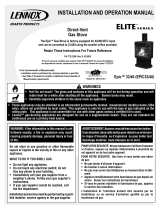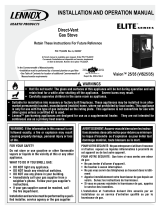
IMPORTANT WARNINGS / CAUTIONS
CAUTION: Read this manual thoroughly before starting installation. For your safety, follow the installation, op-
eration and maintenance instructions exactly without deviation. Failure to follow these instructions may result
in a possible fire hazard and may void the warranty. If this appliance is not properly installed, a house fire may
result. Contact local building or fire officials about restrictions and installation inspection in your area.
PAGE 2
1. WARNING: Improper assembly, installation, ad-
justment, alteration, service or maintenance can
cause injury and / or property damage. Installa-
tion and service must be performed by a quali-
fied installer, service agency or the gas supplier.
Except when complying with local codes, any
deviation from the installation and / or operating
instructions contained in this manual will void
the appliance warranty and may be hazardous.
2. Due to high temperatures, this appliance should
be located out of traffic and away from furniture,
draperies and not in windy or drafty areas.
3. The appliance must NOT be connected to a
chimney flue serving a separate solid-fuel burn-
ing appliance.
4. CAUTION: HOT WHILE IN OPERATION. An appli-
ance hot enough to warm your home can se-
verely burn anyone touching it. Keep children,
clothing and furniture away. Contact may cause
skin burns. Do not let children touch the appli-
ance. Train them to stay a safe distance from the
unit.
5. Do not place clothing or other flammable material
on or near the gas appliance. The minimum
clearances must be maintained for all combusti-
ble surfaces and materials including; furniture,
carpet, drapes, clothing, wood, papers, etc.
6. Do not connect 110-12 VAC (residential line volt-
age) to the gas control valve or control wiring
system of the unit.
7. Any safety screen or guard removed for servic-
ing must be replaced prior to operating the appli-
ance.
8. WARNING: Use only the glass door certified with
this appliance. Exercise caution to protect glass
from impact. Do not operate the appliance with
broken glass or use substitute materials.
9. DO NOT USE this appliance if any part has been
under water. Immediately call a qualified service
technician to inspect the appliance and replace
any part of the control system and gas control
which has been under water.
10. Do not burn wood or other material in this heater.
11. WARNING: The appliance area must be kept clear
and free from combustible materials, gasoline
and other flammable vapors and liquids.
12. Do not use a blower insert, heat exchanger insert
or other accessory not approved for use with this
appliance.
13. This appliance is not for use with air filters.
14. The appliance should be inspected and main-
tained at least annually by a professional service
person. More frequent cleaning may be required
due to excessive lint from carpeting, bedding ma-
terial, etc. It is imperative that control compart-
ments, burners and circulating air passageways
of the appliance be kept clean.
15. This appliance is only for use with the type of
gas indicated on the rating label (located inside
control panel). This appliance is not convertible
for use with other fuel unless a certified kit is
used.
16. CAUTION: Under no circumstances should these
appliances be vented to other rooms or build-
ings. These appliances must only be vented to
the outside. Vent terminations shall not be re-
cessed into a wall or siding (Vent must terminate
vertical).
17. This appliance is equipped with a safety control
system (spill switch) designed to protect against
improper venting of combustion products or vent
blockage.
18. Never seal the opening at the rear of the stove.
19. Provisions must be made to ensure an adequate
supply of combustion and draft hood dilution air
to the room where the appliance is installed.
20. It is imperative that the flow passages of the vent
termination cap remain unrestricted.
21. WARNING: These appliances must be properly
connected to a venting system. Operation of
these gas appliances when not connected to a
properly installed and maintained venting system
can result in carbon monoxide (CO) poisoning
and possible death.
22. WARNING: Do not modify the venting system,
appliance, or controls in any way. Be advised,
any modification can be dangerous.
23. IMPORTANT: Do not exceed the maximum hori-
zontal runs allowed. Installation in areas exposed
to strong winds may cause sooting.
24. SAVE THESE INSTRUCTIONS.



























